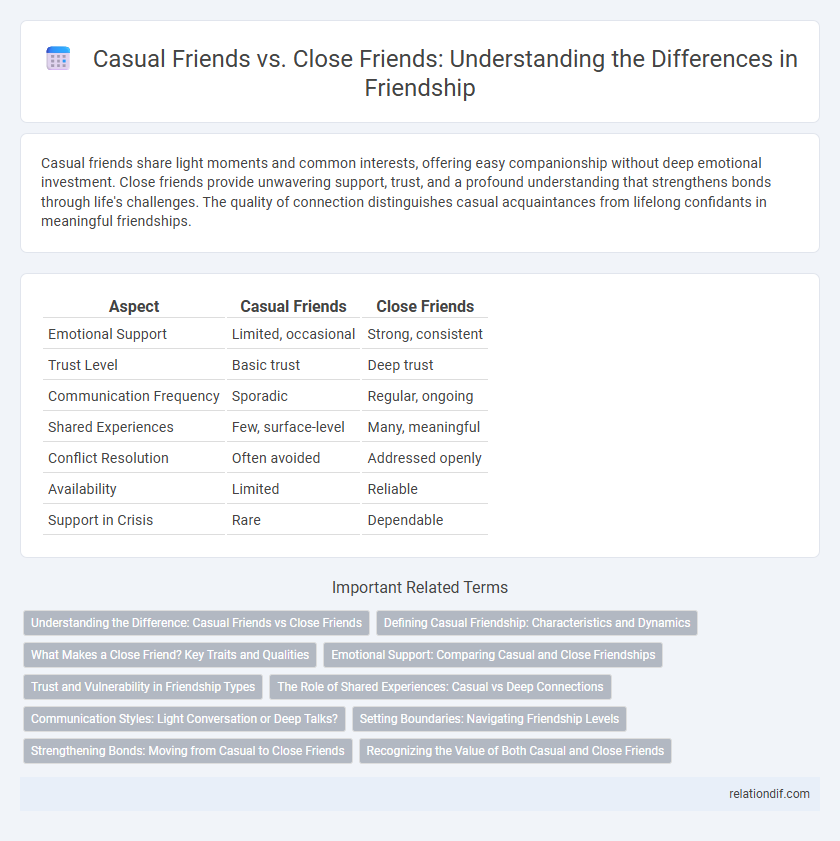Casual friends share light moments and common interests, offering easy companionship without deep emotional investment. Close friends provide unwavering support, trust, and a profound understanding that strengthens bonds through life's challenges. The quality of connection distinguishes casual acquaintances from lifelong confidants in meaningful friendships.
Table of Comparison
| Aspect | Casual Friends | Close Friends |
|---|---|---|
| Emotional Support | Limited, occasional | Strong, consistent |
| Trust Level | Basic trust | Deep trust |
| Communication Frequency | Sporadic | Regular, ongoing |
| Shared Experiences | Few, surface-level | Many, meaningful |
| Conflict Resolution | Often avoided | Addressed openly |
| Availability | Limited | Reliable |
| Support in Crisis | Rare | Dependable |
Understanding the Difference: Casual Friends vs Close Friends
Casual friends share light interactions and social activities without deep emotional investment, often formed through common environments like work or hobbies. Close friends offer emotional support, trust, and vulnerability, building a bond through shared experiences and consistent communication. Recognizing these differences helps manage expectations and strengthens meaningful relationships.
Defining Casual Friendship: Characteristics and Dynamics
Casual friendships are characterized by infrequent interaction, shared interests, and low emotional intimacy, often formed in settings like workplaces, classes, or social events. These relationships typically lack deep personal disclosure and sustained commitment, functioning primarily as light, enjoyable connections without significant expectations. The dynamics revolve around convenience and mutual enjoyment rather than strong emotional support or loyalty found in close friendships.
What Makes a Close Friend? Key Traits and Qualities
A close friend demonstrates unwavering trust, deep empathy, and consistent support, fostering a safe space for vulnerability and authentic connection. These key traits include active listening, reliability during challenging times, and genuine emotional investment that transcends superficial interactions typical of casual friends. The strength of a close friendship lies in mutual respect, shared values, and a reciprocal commitment to each other's well-being.
Emotional Support: Comparing Casual and Close Friendships
Close friendships provide deeper emotional support through consistent empathy, trust, and understanding, fostering a secure environment for sharing personal struggles and triumphs. Casual friends offer limited emotional support, often confined to lighter conversations and social interactions without the same level of vulnerability or commitment. Studies indicate that strong emotional bonds in close friendships contribute significantly to mental well-being and resilience during stressful times.
Trust and Vulnerability in Friendship Types
Trust in close friendships is deeply rooted in consistent emotional support and shared vulnerabilities, enabling open communication and mutual understanding. Casual friends typically engage in lighter interactions, where trust remains surface-level and vulnerability is limited to less sensitive topics. The depth of trust and willingness to be vulnerable fundamentally distinguishes close friends from casual acquaintances.
The Role of Shared Experiences: Casual vs Deep Connections
Shared experiences shape the depth of friendships, with casual friends bonding over routine or surface-level activities, while close friends build trust and emotional intimacy through meaningful, often challenging moments. The frequency and emotional intensity of shared experiences contribute significantly to the strength of a connection, distinguishing casual acquaintances from lifelong confidants. Neuropsychological studies reveal that deep connections release oxytocin, reinforcing trust and long-term attachment beyond superficial interactions common in casual friendships.
Communication Styles: Light Conversation or Deep Talks?
Casual friends typically engage in light conversation, focusing on everyday topics and shared interests that maintain a comfortable and low-pressure dynamic. Close friends, however, often participate in deep talks that explore personal feelings, values, and experiences, strengthening emotional bonds and trust. Communication styles reveal the level of intimacy, with casual friendships favoring surface-level exchanges and close friendships fostering meaningful dialogues.
Setting Boundaries: Navigating Friendship Levels
Setting boundaries between casual friends and close friends is essential for maintaining healthy relationships by clearly defining the level of emotional support and personal sharing appropriate in each friendship type. Casual friends typically require minimal boundaries, involving light interactions and general topics, while close friends demand more explicit boundaries around trust, vulnerability, and mutual expectations. Understanding and respecting these distinctions helps prevent misunderstandings and fosters stronger, more balanced social connections.
Strengthening Bonds: Moving from Casual to Close Friends
Strengthening bonds between casual and close friends involves consistent communication, shared experiences, and mutual support that fosters trust and emotional intimacy. Engaging in meaningful conversations and participating in activities that reveal personal values accelerates the transition from superficial interactions to deeper connections. Regularly investing time and showing genuine interest cultivates resilience in the friendship, transforming casual acquaintances into loyal, close friends.
Recognizing the Value of Both Casual and Close Friends
Casual friends offer social variety and light-hearted interactions that enrich daily life, while close friends provide deep emotional support and trust essential for personal growth. Recognizing the unique value of both types of friendships allows individuals to cultivate a balanced social network that meets diverse emotional and social needs. Embracing the complementary roles of casual and close friends fosters resilience and well-being through varied sources of connection.
casual friends vs close friends Infographic

 relationdif.com
relationdif.com